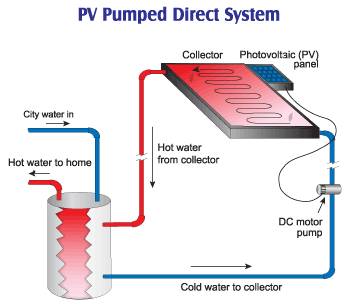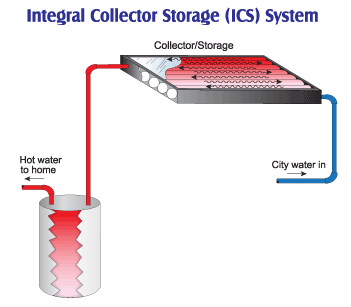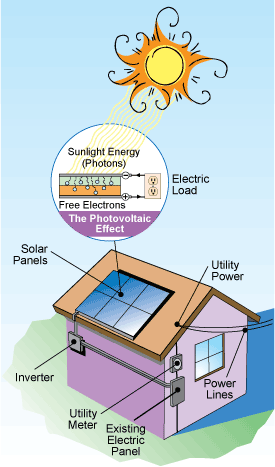

SOLAR
Solar technology can be divided into two categories, solar thermal and photovoltaics (PV). Solar thermal refers to solar water heating or pool heating, whereas photovoltaic is used to produce electricity
(photo = light; voltaic = electricity).
SOLAR WATER HEATING
 Use the solar water heating calculator to see the energy, cost and environmental savings potential of residential solar hot water systems in Florida.
Use the solar water heating calculator to see the energy, cost and environmental savings potential of residential solar hot water systems in Florida.
How Solar Water Heating Systems Work:
 |
 |
These are various types of solar water heating systems. Learn about the other types of systems at the Florida Solar Energy Center’s Web site.
PHOTOVOLTAICS
A photovoltaic (PV) system is a good way to provide "green power" to your home. The PV panels are composed of many solar cells, which convert the radiant energy of the sun into electricity.
So why isn't everyone using PV now? Cost. A typical household system may cost $20,000 to $30,000. In years past, PV was cost prohibitive for many, but as oil, gas, and electricity prices increase, PV is becoming more of a viable option. Photovoltaics is an investment that produces an immediate return. Can you say that about a new car?
How a Photovoltaic System Works:
 |
Solar Panels: |
Convert sunlight instantly into DC electric power. |
Inverter: |
Converts DC power into standard household AC power for use in the home and synchronizes with utility power. During a utility failure, the inverter will automatically turn off and the home will not have power. When the failure is over, the inverter will start again automatically. | |
Utility Meter: |
Spins backward when solar power production exceeds house demand, selling power back to the utility. | |
Existing Electric Panel: |
Distributes solar electricity to loads in the house. | |
Utility Power: |
Is automatically provided at night and during the day when your demand exceeds you solar productions. |